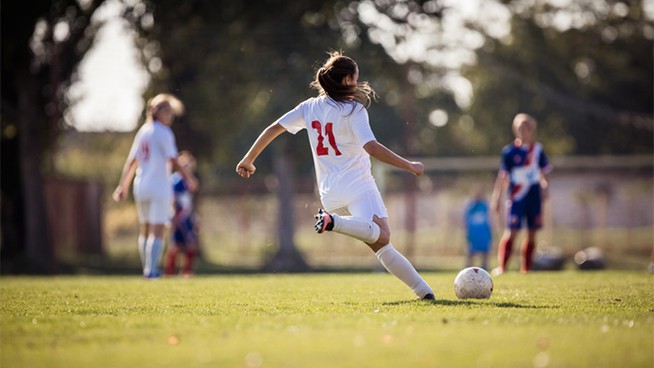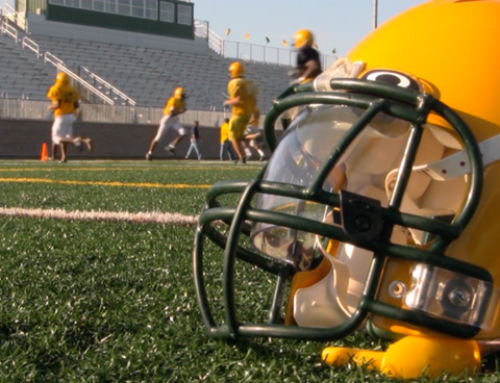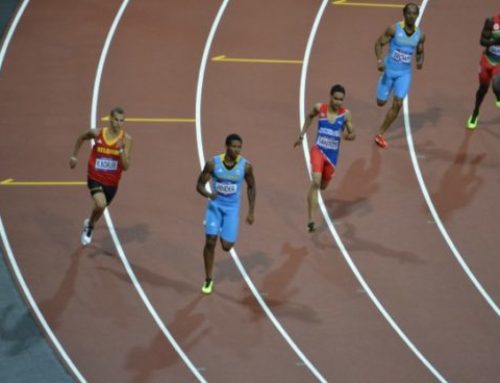The Gauntlet: How This ‘Magic’ Testing Method Pumps Out Sprinting PRs
PRs are fun.
Setting a new PR while sprinting through a tunnel of your rowdy, exuberant teammates?
That’s really fun.
Tony Holler, head track coach at Plainfield (Illinois) North High School and creator of the Feed the Cats training philosophy, believes fast and fun go hand in hand.
“My last 20 years or so has been a journey to find things that make track un-suck. To find ways I can get kids to perform at high levels and say, ‘I like this,’” says Holler.
In his experience, few tools are as powerful for that as Gauntlet Runs.
Just got asked, “What is a GAUNTLET 40?” We do them twice a year. 61% of the participants run a PR. Powerful stuff. pic.twitter.com/qunMxAkvml
— Tony Holler (@pntrack) November 20, 2019
The concept is simple: Once you’ve recorded a significant number of times for an athlete in a given drill, see if having them run in a lane surrounded by vocal, high-energy teammates helps them run faster.
Holler first utilized a Gauntlet 40 with his Plainfield North team in 2011.
“The Gauntlet was something I tried with the idea that just maybe kids would run faster if their teammates were cheering for them,” says Holler.
“At first, it was like, ‘OK guys, we’re going to sprint through a tunnel of your teammates. We’re going to call it a Gauntlet. And the people lining the track, making up the Gauntlet, are just going to raise hell and clap. But please don’t touch the runner.”
The results were stunning.
65 percent of his athletes clocked a 40-Yard Dash PR (hand-timed) during that first Gauntlet session. 68 percent clocked 10-Meter Fly PRs (laser-timed).
Overall, 96 percent of the athletes ran faster than their average time during the workout.
It was a distance the athletes had sprinted (and been timed in) hundreds of times before in the exact same setting under the exact same conditions. The only difference was the overwhelming encouragement from their teammates.
“Kids actually ran faster than they’d ever run in their lifetime because we did that,” says Holler, whose coaching resume includes three IHSA State Track Championships.
That day confirmed his suspicion that love, support and excitement could be performance-enhancing drugs, and the Gauntlet has since become a staple of his program.
Plainfield North now holds two “Gauntlet Days” every year. Like clockwork, more than half of their athletes will hit new PRs in that setting.
Of course, if the speed increases completely vanished when the team went back to their typical workouts, the long-term effectiveness of the exercise would be rather unimpressive. Sure, new PRs were set and the athletes had fun, but if the improvements aren’t sustainable, it’s little more than an odd phenomenon.
However, Holler has found that the faster times tend to stick. When an athlete discovers a speed they’d never achieved before, it’s not a fluke. They’ve tapped into a greater percentage of their own speed potential, and when that happens, it’s often a sort of mental and physical epiphany.
“What I’m trying to do is get kids to find speeds that they’ve never found before,” says Holler. “I’ve had freshmen who’ve gone from 4.90 to 4.60 in the 40-Yard Dash because kids were cheering and excited. Obviously, that means those 4.90s were not the best they could do. Some switch got flipped, and that kid went crazy. And that kid who runs that 4.60 never goes back to 4.90. It’s like you’ve broken down that wall.”
With inspiration from Holler, Justin Kinseth, head track & field coach at University of Wisconsin-Oshkosh, recently tested his athletes in the 30-Meter Fly using a Gauntlet format.
“We actually had one athlete PR by .16 seconds, which was shocking considering we run Fly 30s fairly often. Many athletes even hit a preseason PR on the first rep, which is also rare,” Kinseth told STACK.
“I felt the Gauntlet simply created a heightened sense of the athlete’s surroundings. Much like clapping for a jumper on the runway, the athlete gets in ‘the zone’ where their lizard brain kicks in and they simply focusing on running fast.”
If that sounds appealing, Holler lays out a few guidelines he believes essential to unlocking the full magic of the Gauntlet.
For one, you need to use a distance and setup the athletes are very familiar with, with no other procedures changing aside from teammates lining up on either side of the running lane. This should be a run they’ve been timed in many times before.
“The key thing is that you have solid data before you do it. You would never do a Gauntlet on the first day of sprint practice, because then you cannot make the incredibly cool teaching point to kids that when we support each other, we all do better,” says Holler, who’s made the concept of recording, ranking and publishing results a pillar of his program.
“When you can use data to actually show how incredibly important the support of your peers, the support of your teammates really is, I think it’s a great message.”
Building up that exposure also ensures the athlete’s bodies are physically prepared for sprinting at a velocity they might’ve never achieved previously.
And while new PRs are certainly desirable for any athlete or coach, Holler emphasizes that making Gauntlet Workouts a relative rarity are key to their effectiveness. If it becomes mundane, it loses its magic.
“It’s important we only do it twice a year,” says Holler. “Otherwise, kids will feel, ‘Oh, this is what we do every day.’”
Then, you need buy-in. Holler says the athletes’ enthusiasm during his first couple Gauntlet sessions at Plainfield North was off the charts, but as it’s become a bi-annual tradition, that organic excitement isn’t quite as feverish.
“I will say the Gauntlet is a little more work now. Because the first couple times we did it, kids were much more enthusiastic about clapping and having a big time. But now that we’ve done it twice a year since 2011, it’s not quite as big of a deal,” says Holler. “So I have to tell them how if you want people to really help you, you have to really help them. And that’s a good message.”
If you’re a coach who’d like to try a Gauntlet Run with your athletes, the biggest thing is to make sure they’re trained (and more specifically, trained for the specific distance they’ll be running) before you utilize it.
“If you’re not with your team until March, do three weeks of training, then do a Gauntlet late in March,” says Holler. “Or if you’ve got a speed camp for two weeks, sprint a bunch, then at the end of the speed camp, do a Gauntlet.”
READ MORE:
RECOMMENDED FOR YOU
MOST POPULAR
The Gauntlet: How This ‘Magic’ Testing Method Pumps Out Sprinting PRs
PRs are fun.
Setting a new PR while sprinting through a tunnel of your rowdy, exuberant teammates?
That’s really fun.
Tony Holler, head track coach at Plainfield (Illinois) North High School and creator of the Feed the Cats training philosophy, believes fast and fun go hand in hand.
“My last 20 years or so has been a journey to find things that make track un-suck. To find ways I can get kids to perform at high levels and say, ‘I like this,’” says Holler.
In his experience, few tools are as powerful for that as Gauntlet Runs.
Just got asked, “What is a GAUNTLET 40?” We do them twice a year. 61% of the participants run a PR. Powerful stuff. pic.twitter.com/qunMxAkvml
— Tony Holler (@pntrack) November 20, 2019
The concept is simple: Once you’ve recorded a significant number of times for an athlete in a given drill, see if having them run in a lane surrounded by vocal, high-energy teammates helps them run faster.
Holler first utilized a Gauntlet 40 with his Plainfield North team in 2011.
“The Gauntlet was something I tried with the idea that just maybe kids would run faster if their teammates were cheering for them,” says Holler.
“At first, it was like, ‘OK guys, we’re going to sprint through a tunnel of your teammates. We’re going to call it a Gauntlet. And the people lining the track, making up the Gauntlet, are just going to raise hell and clap. But please don’t touch the runner.”
The results were stunning.
65 percent of his athletes clocked a 40-Yard Dash PR (hand-timed) during that first Gauntlet session. 68 percent clocked 10-Meter Fly PRs (laser-timed).
Overall, 96 percent of the athletes ran faster than their average time during the workout.
It was a distance the athletes had sprinted (and been timed in) hundreds of times before in the exact same setting under the exact same conditions. The only difference was the overwhelming encouragement from their teammates.
“Kids actually ran faster than they’d ever run in their lifetime because we did that,” says Holler, whose coaching resume includes three IHSA State Track Championships.
That day confirmed his suspicion that love, support and excitement could be performance-enhancing drugs, and the Gauntlet has since become a staple of his program.
Plainfield North now holds two “Gauntlet Days” every year. Like clockwork, more than half of their athletes will hit new PRs in that setting.
Of course, if the speed increases completely vanished when the team went back to their typical workouts, the long-term effectiveness of the exercise would be rather unimpressive. Sure, new PRs were set and the athletes had fun, but if the improvements aren’t sustainable, it’s little more than an odd phenomenon.
However, Holler has found that the faster times tend to stick. When an athlete discovers a speed they’d never achieved before, it’s not a fluke. They’ve tapped into a greater percentage of their own speed potential, and when that happens, it’s often a sort of mental and physical epiphany.
“What I’m trying to do is get kids to find speeds that they’ve never found before,” says Holler. “I’ve had freshmen who’ve gone from 4.90 to 4.60 in the 40-Yard Dash because kids were cheering and excited. Obviously, that means those 4.90s were not the best they could do. Some switch got flipped, and that kid went crazy. And that kid who runs that 4.60 never goes back to 4.90. It’s like you’ve broken down that wall.”
With inspiration from Holler, Justin Kinseth, head track & field coach at University of Wisconsin-Oshkosh, recently tested his athletes in the 30-Meter Fly using a Gauntlet format.
“We actually had one athlete PR by .16 seconds, which was shocking considering we run Fly 30s fairly often. Many athletes even hit a preseason PR on the first rep, which is also rare,” Kinseth told STACK.
“I felt the Gauntlet simply created a heightened sense of the athlete’s surroundings. Much like clapping for a jumper on the runway, the athlete gets in ‘the zone’ where their lizard brain kicks in and they simply focusing on running fast.”
If that sounds appealing, Holler lays out a few guidelines he believes essential to unlocking the full magic of the Gauntlet.
For one, you need to use a distance and setup the athletes are very familiar with, with no other procedures changing aside from teammates lining up on either side of the running lane. This should be a run they’ve been timed in many times before.
“The key thing is that you have solid data before you do it. You would never do a Gauntlet on the first day of sprint practice, because then you cannot make the incredibly cool teaching point to kids that when we support each other, we all do better,” says Holler, who’s made the concept of recording, ranking and publishing results a pillar of his program.
“When you can use data to actually show how incredibly important the support of your peers, the support of your teammates really is, I think it’s a great message.”
Building up that exposure also ensures the athlete’s bodies are physically prepared for sprinting at a velocity they might’ve never achieved previously.
And while new PRs are certainly desirable for any athlete or coach, Holler emphasizes that making Gauntlet Workouts a relative rarity are key to their effectiveness. If it becomes mundane, it loses its magic.
“It’s important we only do it twice a year,” says Holler. “Otherwise, kids will feel, ‘Oh, this is what we do every day.’”
Then, you need buy-in. Holler says the athletes’ enthusiasm during his first couple Gauntlet sessions at Plainfield North was off the charts, but as it’s become a bi-annual tradition, that organic excitement isn’t quite as feverish.
“I will say the Gauntlet is a little more work now. Because the first couple times we did it, kids were much more enthusiastic about clapping and having a big time. But now that we’ve done it twice a year since 2011, it’s not quite as big of a deal,” says Holler. “So I have to tell them how if you want people to really help you, you have to really help them. And that’s a good message.”
If you’re a coach who’d like to try a Gauntlet Run with your athletes, the biggest thing is to make sure they’re trained (and more specifically, trained for the specific distance they’ll be running) before you utilize it.
“If you’re not with your team until March, do three weeks of training, then do a Gauntlet late in March,” says Holler. “Or if you’ve got a speed camp for two weeks, sprint a bunch, then at the end of the speed camp, do a Gauntlet.”
READ MORE:











